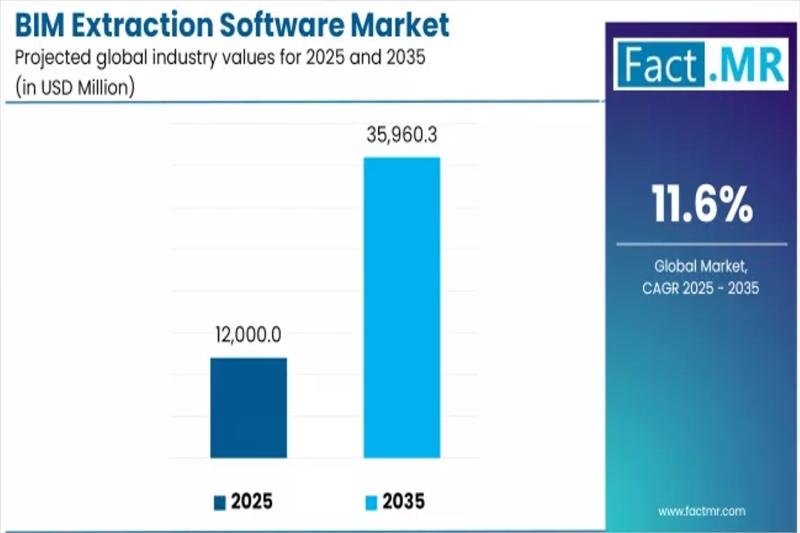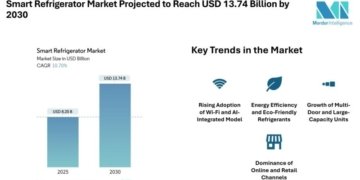The global BIM extraction software market is projected to grow from USD 10.78 billion in 2024 to USD 35.96 billion by 2035, achieving a compound annual growth rate (CAGR) of 11.6%. This growth is driven by the increasing demand for digital construction solutions, government mandates for BIM adoption, and advancements in AI and cloud computing. BIM extraction software streamlines workflows by converting complex building data into usable formats, enhancing project efficiency, accuracy, and sustainability in the architecture, engineering, and construction (AEC) sectors.
Browse for Full Report: https://www.factmr.com/report/bim-extraction-software-market
Key Drivers of the BIM Extraction Software Market
The BIM extraction software market is propelled by the need for precision and efficiency in construction project management. Traditional methods often face cost overruns and delays, which BIM software mitigates through real-time data access, clash detection, and quantity takeoff. Global infrastructure investments in urban transit, green buildings, and smart cities, such as China’s smart city initiatives and the U.K.’s Level 2 BIM mandate, drive demand for advanced planning tools. For instance, the U.S. General Services Administration’s BIM mandates for public projects have accelerated adoption.
Integration of AI, cloud computing, and IoT enhances BIM capabilities, enabling scalable, collaborative platforms. Autodesk’s Forma (May 2023) exemplifies this by automating design tasks and incorporating environmental analytics. Tightening environmental regulations push stakeholders to use BIM for sustainability assessments and lifecycle cost evaluations, aligning with green building standards like LEED. The rise of digital twins and smart infrastructure further boosts demand for BIM extraction tools, supporting data-driven decision-making across project lifecycles.
Regional Trends in the BIM Extraction Software Market
North America holds a significant share, driven by the U.S. and Canada’s advanced construction sector and federal BIM mandates. The U.S. leads with widespread adoption in commercial and infrastructure projects, supported by a robust digital ecosystem and vendors like Autodesk and Trimble. Canada’s smart city initiatives and green building focus further drive growth.
Western Europe is a key market, led by the U.K., Germany, and France. The U.K.’s Level 2 BIM mandate for public projects has set a regional standard, promoting adoption for sustainability and asset management. Germany’s Industry 4.0 and focus on carbon-neutral construction drive demand for energy-efficient BIM solutions. France emphasizes BIM for urban and heritage projects, integrating IoT for smart infrastructure.
East Asia exhibits rapid growth, with China, Japan, and South Korea at the forefront. China’s Made in China 2025 initiative and smart city projects, like those in Shanghai, fuel BIM adoption. Japan integrates BIM with AI and IoT for precision construction, while South Korea focuses on high-density urban projects. India’s emerging market shows potential due to infrastructure investments.
Latin America, Middle East, and Africa (LAMEA) are nascent but growing. Brazil and Mexico adopt BIM for transportation and commercial projects, while the UAE and South Africa leverage BIM for smart infrastructure and tourism-driven developments. Limited digital literacy and infrastructure slow adoption but offer long-term potential.
Want a Sample Before Buying? Download Free Sample: https://www.factmr.com/connectus/sample?flag=S&rep_id=7207
Challenges and Restraining Factors
High initial costs and complex implementation deter small and medium-sized enterprises (SMEs), as advanced BIM platforms require significant investment and technical infrastructure. Interoperability issues between software providers, like Autodesk and Bentley, create data silos, hindering collaboration. The lack of standardized BIM data formats exacerbates this, increasing integration costs.
A steep learning curve and shortage of skilled professionals, especially in developing regions, limit adoption. Data security concerns with cloud-based platforms, as seen in stakeholder hesitancy to share sensitive project data, pose risks. Resistance to organizational change and reliance on traditional workflows further slow digital transformation, despite supportive regulations.
Key Players and Competitive Landscape
The BIM extraction software market is competitive, with key players like Autodesk Inc., Bentley Systems, Trimble, Nemetschek Group, and FARO Technologies leading through innovation in AI, cloud, and digital twin technologies. Autodesk’s Forma and FARO’s As-Built Modeler (June 2023) enhance scan-to-BIM workflows. Niche players like ClearEdge3D and PointCab GmbH focus on specialized point cloud solutions, while Geo-Plus and Innovaya offer tailored tools for SMEs. Strategic partnerships, such as Autodesk’s collaborations with system integrators, and open BIM standards drive interoperability and market growth.
Conclusion
The BIM extraction software market is set to reach USD 35.96 billion by 2035 with an 11.6% CAGR, driven by digital construction demands, government mandates, and AI-cloud integration. North America and Western Europe lead, while East Asia grows rapidly due to smart city initiatives. LAMEA shows emerging potential despite infrastructure gaps. Key players like Autodesk and Trimble innovate, but high costs, interoperability issues, and skill shortages pose challenges. As construction embraces digitalization and sustainability, BIM extraction software will remain pivotal for efficient, data-driven project management.
Check out More Related Studies Published by Fact.MR Research:
Clientless Remote Support Software Market: https://www.factmr.com/report/345/clientless-remote-support-software-market
Nucleic Acid Extraction System Market: https://www.factmr.com/report/432/nucleic-acid-extraction-system-market
Dust Extraction System Market: https://www.factmr.com/report/839/dust-extraction-system-market
Automated Power Generation Dispatch Software Market: https://www.factmr.com/report/1467/automated-power-generation-dispatch-software-market
Contact:
US Sales Office
11140 Rockville Pike
Suite 400
Rockville, MD 20852
United States
Tel: +1 (628) 251-1583, +353-1-4434-232
Email: sales@factmr.com
About Us:
Fact.MR is a distinguished market research company renowned for its comprehensive market reports and invaluable business insights. As a prominent player in business intelligence, we deliver deep analysis, uncovering market trends, growth paths, and competitive landscapes. Renowned for its commitment to accuracy and reliability, we empower businesses with crucial data and strategic recommendations, facilitating informed decision-making and enhancing market positioning.
This release was published on openPR.

















